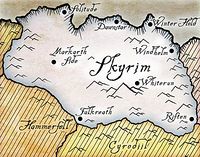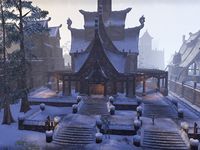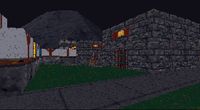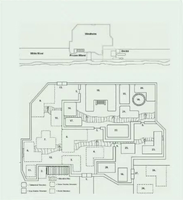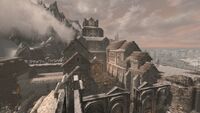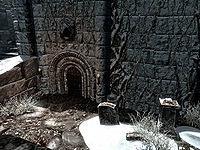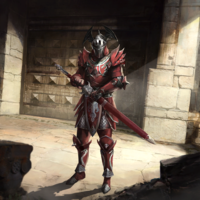Lore:Windhelm
| Windhelm | |
|---|---|
| Type | Settlement |
| Continent | Tamriel |
| Province | Skyrim |
| Hold | Eastmarch (Giant's Run) |
| Appears in | Arena, Skyrim, ESO |
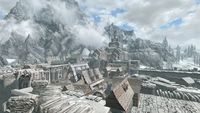
Windhelm, the City of Kings, also known as "Ysgramor's city",[1][2] is a city in northeastern Skyrim, close to the border with Morrowind, and is the only substantial city in the Hold of Eastmarch.
It is not only the oldest extant city in Skyrim[3] (the oldest city being Saarthal),[4][5] but it does hold the tile of being the oldest continuously inhabited human settlement in Tamriel.[6] Windhelm was once the capital of the First Empire of the Nords and the old palace of the Ysgramor dynasty, the Palace of the Kings, still stands in the center of the city.[4]
Morvunskar is located on the strategic high ground southwest of Windhelm, overlooking the main roads leading to the city. Like most Nord cities, Windhelm has a Hall of the Dead where bodies are interred, overseen by a Priest of Arkay who ensures that corpses are properly consecrated and cared for.[6][7] The city's arena is known as the Hall of Trials.[6]
History[edit]
Windhelm was founded by the legendary Ysgramor and the crew of his ship, the Ylgermet, following the Battle of the Moesring in the late Merethic Era. According to Nordic tradition, after the Five Hundred Companions disbanded, the Ylgermet's crew stumbled upon the barrow of Yngol, Ysgramor's son. When Ysgramor looked south and saw where the White River flowed into the Sea of Ghosts, he decreed that a great city should be built there to serve as a monument to the glories of mankind, a place from where he could gaze upon the hill of Yngol's barrow, and a gateway to guard Skyrim's interior against incursion via the river. It was built by Snow Elf slaves of the early Nords.[1]
Captive elves were forced to build the city in the architectural style of their captors, and it is alleged that as many elves died during Windhelm's construction as were killed by the Ylgermet's crew before they had arrived at the site. The city's great bridge was designed to allow a vigilant watch on the White River for elven attacks, and Ysgramor's palace, the Palace of the Kings, towered over the city to show man's dominion over the very winds that had caused Yngol's death on the voyage from Atmora. An elaborate tomb was built in the catacombs beneath Windhelm to serve as Ysgramor's final resting place upon his death, but was never used because he chose to be buried by the sea.[1]
Ysgramor's descendants would rule the burgeoning territory of the Nords from Windhelm. When Harald assumed the mantle of High King in 1E 143, he relinquished his holdings in Atmora and established Skyrim as an independent kingdom with Windhelm as its capital.[8][4] During the time of Vrage the Gifted, the city became the capital of not just Skyrim, but the First Empire of the Nords that also encompassed High Rock, Morrowind, and parts of Cyrodiil.[4] When the First Empire of the Nords later collapsed amidst the War of Succession that raged from 1E 369 to 1E 420, the city was sacked.[4]
In 2E 431, after the onset of the Interregnum, High King Logrolf was assassinated, precipitating a succession dispute between his daughter, Freydis, and Jarl Svartr of Solitude. While Freydis was accepted as High Queen by the Crown of Verity in Windhelm, a partial Moot convened in Solitude and declared Svartr to be High King. From then on, Skyrim was divided into two kingdoms, with Windhelm serving as the capital of Eastern Skyrim and the seat of Freydis and her line.[9][UOL 1]
Windhelm was sacked a second time in 2E 572 by the Akaviri army of Ada'Soom Dir-Kamal, and then-High Queen Mabjaarn Flame-Hair was slain in battle along with her daughter, Nurnhilde, who briefly succeeded her.[10] The Palace of the Kings was one of the few of the city's original structures that survived these events, however it was badly damaged. The palace court was temporarily displaced as High King Jorunn, who succeeded Nurnhilde, elected to repair the rest of city first, and work on the palace was not completed until 2E 582.[4][11] At some point during the Second Era, the city also suffered under the disastrous reign of Jarl Elgryr the Unminded, who taxed his citizens to the point of destitution and eventually drove them to revolt.[12]
In the ninth century of the Second Era, during the formation of the Third Empire of Tamriel, Windhelm served as a base for Imperial troops guarding the Dunmeth Pass into Morrowind prior to that region's incorporation into the Empire.[4]
During the Imperial Simulacrum in the late Third Era, the city-state of Windhelm was an active settlement, being ruled by King Asgan. It had a rivalry with Riften and Winterhold.[13] It was neighbored by several settlements, including Amol to the west, Dragon Wood to the south, Laintar Dale to the southwest, and Morrowind to the east, towards Cormar View.[14][15] When the Oblivion Crisis broke out in 3E 433, Skyrim was under siege and faced severe casualties. It was said that everything between Falkreath and Windhelm was laid to waste by the Daedric hordes.[16]
By 4E 201, Windhelm was the center of the Stormcloak Rebellion against the Third Empire. Jarl Ulfric Stormcloak, leader of the rebellion, sought to liberate Skyrim from Imperial control to protect the traditional Nord way of life and restore the right to worship Talos, which had been banned Empire-wide by the White-Gold Concordat. In open defiance of the ban, Windhelm's Temple of Talos was kept open throughout the conflict with the Empire. The city had also come to house a substantial population of Dunmer refugees who had fled Morrowind in the aftermath of the Red Year. The elves were relegated to the city's run-down Snow Quarter, later named the Gray Quarter after the Dunmer refugees, and faced constant suspicion from the xenophobic local Nords.[7]
Known Rulers[edit]
- See this section in the following article: Eastmarch
Gallery[edit]
Notes[edit]
- Arena was originally conceived as a fighting game featuring a tournament that took the player to each of Tamriel's cities to challenge different gladiatorial teams. According to a file from that stage of development left behind in the final game, Windhelm's gladiatorial team would have been called "the Paladins".[UOL 2]
See Also[edit]
- For game-specific information, see the Skyrim and Elder Scrolls Online articles.
References[edit]
- ^ a b c Songs of the Return
- ^ Serana's dialogue in Skyrim: Dawnguard
- ^ Loading screen in Skyrim
- ^ a b c d e f g Pocket Guide to the Empire, 1st Edition: Skyrim — Imperial Geographical Society, 2E 864
- ^ Before the Ages of Man — Aicantar of Shimerene
- ^ a b c Loading screen in ESO
- ^ a b Events of Skyrim
- ^ Frontier, Conquest — University of Gwylim Press, 3E 344
- ^ The Crown of Freydis — Taleon Mythmaker
- ^ Jorunn the Skald-King — Helgreir Lute-Voice, Bard of Windhelm
- ^ High King Joruun's dialogue in ESO
- ^ The Windhelm Letters — Reylia
- ^ Windhelm location and rumors in Arena
- ^ Map of Skyrim — The Elder Scrolls: Arena
- ^ Map of Morrowind — The Elder Scrolls: Arena
- ^ Tamriel Gate Response rumors in Oblivion
Note: The following references are considered to be unofficial sources. They are included to round off this article and may not be authoritative or conclusive.
